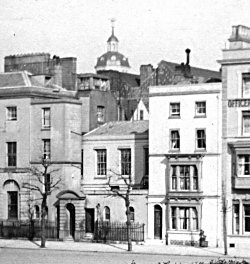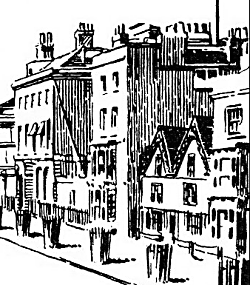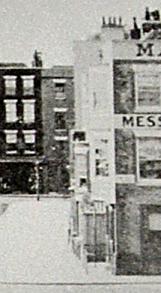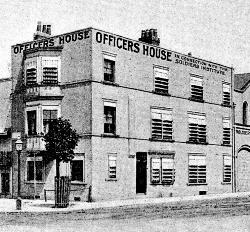
Grand Parade (North-East Side)
Grand Parade has been one of the largest open spaces in Old Portsmouth since the town was founded. It is certainly shown on all maps dating from the earliest in 1540. Originally it may have been left open in order to ensure that anyone approaching the Square Tower could be readily observed but it may also have had something to do with the stability of the ground, it being known that the beach formerly extended much further inland than we see today. Latterly it became identified with the Garrison and the parades of it's soldiers.
The north side of Grand Parade largely survived the ravages of the blitz (see below). Apart from Nos. 1 and 1A all the other buildings are essentially the same as they were before the war but this is not necessarily how they appeared in 1860.

The evidence that will help define the north side of Grand Parade in 1860 is largely contained in a drawing made around 1824 by Commander Spencer Smythe (see extract below with non-relevant parts greyed out). He drew this sketch whilst perched on the Semaphore Tower which at the time was situated on top of the Square Tower. Unfortunately it was not quite high enough for Smythe to see all of the buildings clearly but we can relate all of them to the modern day panorama.

From the two images above we can deduce that Nos. 3-5 plus the last building on the right, which is actually in Penny Street, have survived since 1824. We also know that No. 60 High Street on the left is also essentially the same as it was in 1860. That leaves Nos 1, 1A and 2 which are quite clearly different buildings. The number 1A for the building to the right of No. 60 High Street is a much later identity given that a Gas Company map of 1871 (see below) shows it as an integral part of No. 60 High Street, the two being referred to jointly as Grant and Company's Bank. For the purposes of identifying this building here we will however continue to use the modern number.

We know from the Smythe drawing that No. 1A was set back from the pavement and was somewhat shorter than its neighbours. We can be confident that this same building existed in 1860 as a photograph c1910 (see below) shows the same structure in place. By this time however an extension had been built onto No. 60 High Street which partially obscured No.1A. Indeed the extension appears to be extremely close to the front of No. 1A, so close in fact that it is hard to imagine the owners of the latter agreeing to the construction, unless all the buildings were under common ownership.

The model need not concern itself with the extension to No.60 as it was constructed some time after 1860. We know this from a drawing of the 8th Kings Regiment Memorial (see detail below) in which a relevant part of Grand Parade is seen in the background. The drawing can be dated to around 1870 as the memorial was only in place from 1863 to 1878, and it clearly shows a blank wall at the end of No. 60. The same images also show that the elaborate arch to the right of No. 60 in 1910 did not exist in the 1870s.
Moving on to No.1 Grand Parade we can again use the Kings Memorial image to verify that the building shown by Smythe is still in place in the 1870s. The 1871 map tells us this house is 21 feet wide and, by comparison with No. 60, that it is about 41 feet high.

An examination of the 1910 photo, which also portrays the same building at No. 1, shows that the layout of windows is slightly asymmetrical, all are displaced horizontally eastwards by about one foot. This differs from the Smyth drawing which suggests a symmetrical layout. If there was a change to the facade the reasons for it and the date it may have occurred are unknown.
The Kings Memorial drawing and the photo from which it is derived contain the only known representations of the building that almost certainly existed at No. 2 in 1860. It is a low twin gabled building which the map of 1871 tells us was a Public House called the Vectis. This was probably demolished around 1890 and replaced by Aquitaine House which we see nowadays as No. 2 Grand Parade.
The remaining buildings on the north side of Grand Parade are broadly the same in 2009 as in the Smythe drawing. No. 3 is measured on the ground at 14'3" wide and by proportion 31'6" feet high. No.4 is 22'4" wide and 29'0" high. No. 5 is 24'6" wide and 26'6" high. There are no immediately apparent differences between Nos 3 and 4 as portrayed in 1824 and 2009 but No. 5 is something of an enigma.
Although No. 5 Grand Parade retains the same overall height today as it did in 1824 there is a problem with its width. Today we see an asymmetrical building with three pairs of windows installed as on the Smythe drawing, but we also see an additional window on the left at ground floor level that Smythe does not show, indeed he could not show it as the building he drew was simply not wide enough to accommodate an extra window.
This issue was partially resolved when the current (2010) owner of No. 4 Grand Parade invited the author to view the house on the inside. This revealed that No. 4 in fact extends 6 feet further to the right than is apparent from the exterior dividing line - except for the intrusion of one room at ground level behind the additional window to No. 5. This would allow for the extra width needed to accommodate the additional window, but it doesn't entirely resolve the matter since, if 6 feet were removed from the right of No. 4 and added to the left of No. 5, then the two buildings would have been 17'4" and 31'6" wide respectively whereas they appear much the same width in the Smythe drawing. It would seem that Smythe got it wrong which is not too surprising given that his view of these houses was partially obscured by the chimneys of the houses opposite.

Interestingly, this issue can be further explored using Google Earth (see right). In this we can see that the existing roof to No. 4 extends about 6 feet over the top of No. 5 thereby confirming that the boundary between these two buildings has changed at some point, presumably after Smythe's drawing.

No. 5 presents a further difficulty in that the ornate balcony present today and in all existing photographs was not shown by Smythe. It is so prominent it is inconceivable that he would have failed to notice it which means it must have been erected after 1824. This issue impinges on the previous argument as the balcony extends over that portion of No. 5 which was formerly part of No. 4, indeed the room behind the left side of the balcony is actually in No. 4.
The only visual evidence that may help determine the presence of the balcony in 1860 comes from a very oblique angled photograph which shows the Marine View Hotel around 1860 (see detail, left). Something that could be the balcony is showing just beneath the lower bay window on the left of the Hotel. It is at the right height, but there is an alternative explanation for this feature. In the 1871 map above, there is a projection from the facade of No. 5 at the position where the door is located. The most obvious conclusion is that this is a porch of some kind and what we see below the hotel bay is that porch with a pitched roof. If this theory is correct then the balcony could not have been in place in 1860 - the pitched roof was simply too high for the two to have co-existed.
We know that this photograph must be from the early 1860s as there are no trees on the pavement whereas all images from 1870 onwards show trees at various stages of growth. They were almost certainly planted around between 1865 and 1870 as protective baskets are shown surrounding them in photos from that period. The progression of tree development over the years actually allows us to sequence the surviving photos rather accurately.

The last building on this side of Grand Parade as we have noted above was known as the Marine View Hotel, or 106-108 Penny Street. We know that it later became the Officers section of the Soldiers Institute and more recently the Princess Christian Home for Serviceman. In 2009 it is private residential accommodation known, interestingly, as Marine View. The structure is largely unaltered from the earliest images though Smythe suggests there may have been a bay at ground level on the Grand Parade side as well as at first and second floor levels. Even if this was the case the photo from that era above shows that it did not exist in 1860.
The photograph from 1860 shows some significant differences in the design of the building from that depicted in later images. The earlier walls are probably brick finished rather than rendered, a door is in the position of the left hand window on the east side and the decorative bands and elaborate window frames have not been introduced. The image however does not give us enough of the building to be sure of it's overall appearance.
Documentary Evidence
Post Office Directory (1859) - Henry Bloxham, surgeon, 1 Grand Parade; Henry Pragnell, Vectis Hotel, 3 Grand Parade; James Garratt Esq., 3 Grand Parade; Rev. Nicholas Howard Macgachen, 4 Grand Parade; George Hammond, Marine View Hotel, Grand Parade.
Kelly's (1859) - Henry Pragnell, Vectis Tavern, 3 Grand Parade.
Harrod's (1865) - McGachen, curate, St. Thomas Parish Church; Richard Bailey, Marine View Hotel; Henry Garratt, clerk at Lloyd's agent office, 3 Grand Parade.
The 1861 Census records the following:-
Schedule 202 - Michael H. McGachen (38, Curate at St. Thomas Parish Church), his wife Henrietta (31), daughters Henrietta (8) and Emma (3), sons John R. (2) and William (0), with Fanny White (21, House Servant) and Charlotte Collins (18, Nurse).
Schedule 203 - James Garratt (45, Shipping Agent and Merchant) with his wife Caroline (39) and sons Robert B. and George G. (both 4), with Charlotte Matthews (21, Cook), Ellen Barrett (18, Nursemaid) and Harriet Cooper (15, Nursemaid).
Schedule 204 - Richard Bailey (62, Victualler) with his daughter Rose (26, Barmaid) and Fanny McSheen (24, Barmaid), Mary Mitchell (22, Housemaid) and Harry Hazel (9, Grandson).
Schedule 205 - Henry Bloxham (51) with Mary ?? (46, Servant) and Phoebe Mason (24, Servant).
Schedule 206 - William Halbert (61, Pensioner) with Frances (50, Charwoman) and Sarah Howell (20, Book Binder).
The directories seem somewhat confused over the numbering of 2 and 3 Grand Parade (or just "Parade" as it was recorded in the census), but we can be confident that No. 2 was the Vectis Hotel. There is further confusion over who was landlord at that hostelry; it seems to have been Henry Pragnell in 1859 and Richard Bailey in 1861, though the latter is recorded as being at the Marine View Hotel in 1865 (Harrod's). Schedules 202-206 appear on a single return for the census which allows us to determine that these represent Nos. 4, 3, 2 and 1 Grand Parade, but we do not have enough evidence to say whether the William Halbert of Schedule 206 was living at 1A (as we have described the building at the back of 60 High Street) or at No. 5 Grand Parade for which there appears to be no defined entry.
The schedule before 202, appropriately numbered 201, lists Emma Hailey (56, Shirt Maker) with son Charles (16) and daughter Clara (13) but this appears on a sheet, the latter part of which is out of sequence. There is no apparent solution to this matter at present.
Summary
The appearance of the buildings on the north side of Grand Parade in 1860 can be confidently deduced from the images from the 1860s and 70s with just a little doubt over the interface between Nos. 4 and 5. The balcony to the latter will be omitted in favour of a gabled porch. The Marine View Hotel seems to have been in the throes of change around the beginning of the 1860s allowing us to depict it as before or after without severely compromising the integrity of the model. As the better evidence for it's full width comes from the period after the change, when it was part of the Soldiers Institute, we shall use that.